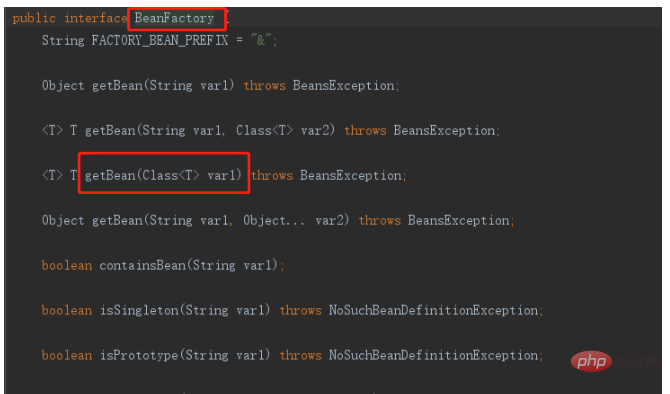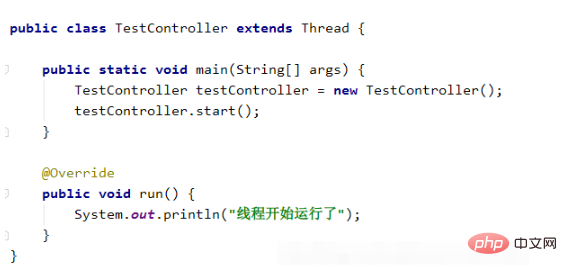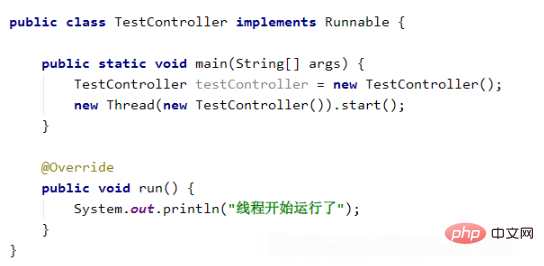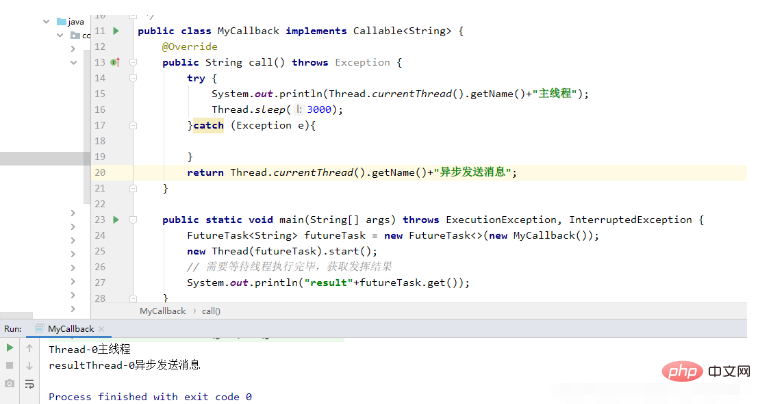 Java
Java
 javaTutorial
javaTutorial
 How to directly call service business class in Java multi-threaded run method
How to directly call service business class in Java multi-threaded run method
How to directly call service business class in Java multi-threaded run method
You should pay attention to directly calling the service business class in the multi-threaded run method
Using the service business class in the Java multi-threaded run method will cause a java.lang.NullPointerException exception. This is due to the business class injected by spring. is null, or the direct new business object is also null.
Multi-threading will prevent injection for thread safety. Therefore, when you want to use the service business class, you need to use the ApplicationContext method to obtain the bean method to obtain the service class.
To obtain the ApplicationContext class, you must implement the ApplicationContextAware interface, as follows:
1 2 3 4 5 6 7 8 9 10 11 12 13 14 |
|
Then use the above method in the run method to create a business object, as follows:
1 |
|
This way it can be used normally The business class is over.
The diagram is as follows







1 2 3 4 |
|
User thread: No It dies as other threads die. There are only two situations where it dies. One is that it terminates due to an exception during operation, and the other is that the program is executed normally and the thread dies
Daemon thread: Dies as the user thread dies. When the user thread dies, the daemon thread also dies, such as the gc garbage collection thread. If the user thread exists, then gc needs to be alive, otherwise it will be useless.
- Several situations of blocking:
- A. Waiting for blocking: The running thread executes wait(), and the JVM will Put it in the waiting queue
- B. Synchronous blocking: When the running thread acquires the synchronization lock of the object, if the synchronization lock is occupied by other threads, the JVM will put the current thread into the lock Pool
- C. Other blocking: When the running thread executes sleep(), join() or issues an IO request, the JVM will set the current thread to the blocking state. When sleep() After execution, the join() thread terminates, and the thread resumes again after IO processing
1 2 3 4 5 6 7 8 |
|
Four rejection strategies of thread pool
When the task cache queue of the thread pool is full and the number of threads in the thread pool reaches maximumPoolSize, if there are still tasks arriving, the task rejection strategy will be adopted. Usually there are The following four strategies:
ThreadPoolExecutor.AbortPolicy: Discard the task and throw RejectedExecutionException.
ThreadPoolExecutor.DiscardPolicy: Discard the task, but do not throw an exception.
ThreadPoolExecutor.DiscardOldestPolicy: Discard the frontmost task of the queue, and then resubmit the rejected task
ThreadPoolExecutor.CallerRunsPolicy: By the calling thread ( The thread that submitted the task) processes the task
The difference between sleep and wait
sleep is a method in the thread, but wait is a method in Object
The sleep method will not release the lock, but wait will release it and will be added to the waiting queue
-
sleep does not need to be awakened, but wait does
Why wait(), notify(), notifyAll() are in the object and not in the Thread class
The lock level in java is the object level instead of the thread level. Each object has a lock, which is obtained through the thread. If the wait() method is in a thread, it is not obvious which lock the thread is waiting for.
The above is the detailed content of How to directly call service business class in Java multi-threaded run method. For more information, please follow other related articles on the PHP Chinese website!

Hot AI Tools

Undresser.AI Undress
AI-powered app for creating realistic nude photos

AI Clothes Remover
Online AI tool for removing clothes from photos.

Undress AI Tool
Undress images for free

Clothoff.io
AI clothes remover

AI Hentai Generator
Generate AI Hentai for free.

Hot Article

Hot Tools

Notepad++7.3.1
Easy-to-use and free code editor

SublimeText3 Chinese version
Chinese version, very easy to use

Zend Studio 13.0.1
Powerful PHP integrated development environment

Dreamweaver CS6
Visual web development tools

SublimeText3 Mac version
God-level code editing software (SublimeText3)

Hot Topics
 1378
1378
 52
52
 Perfect Number in Java
Aug 30, 2024 pm 04:28 PM
Perfect Number in Java
Aug 30, 2024 pm 04:28 PM
Guide to Perfect Number in Java. Here we discuss the Definition, How to check Perfect number in Java?, examples with code implementation.
 Random Number Generator in Java
Aug 30, 2024 pm 04:27 PM
Random Number Generator in Java
Aug 30, 2024 pm 04:27 PM
Guide to Random Number Generator in Java. Here we discuss Functions in Java with examples and two different Generators with ther examples.
 Weka in Java
Aug 30, 2024 pm 04:28 PM
Weka in Java
Aug 30, 2024 pm 04:28 PM
Guide to Weka in Java. Here we discuss the Introduction, how to use weka java, the type of platform, and advantages with examples.
 Smith Number in Java
Aug 30, 2024 pm 04:28 PM
Smith Number in Java
Aug 30, 2024 pm 04:28 PM
Guide to Smith Number in Java. Here we discuss the Definition, How to check smith number in Java? example with code implementation.
 Java Spring Interview Questions
Aug 30, 2024 pm 04:29 PM
Java Spring Interview Questions
Aug 30, 2024 pm 04:29 PM
In this article, we have kept the most asked Java Spring Interview Questions with their detailed answers. So that you can crack the interview.
 Break or return from Java 8 stream forEach?
Feb 07, 2025 pm 12:09 PM
Break or return from Java 8 stream forEach?
Feb 07, 2025 pm 12:09 PM
Java 8 introduces the Stream API, providing a powerful and expressive way to process data collections. However, a common question when using Stream is: How to break or return from a forEach operation? Traditional loops allow for early interruption or return, but Stream's forEach method does not directly support this method. This article will explain the reasons and explore alternative methods for implementing premature termination in Stream processing systems. Further reading: Java Stream API improvements Understand Stream forEach The forEach method is a terminal operation that performs one operation on each element in the Stream. Its design intention is
 TimeStamp to Date in Java
Aug 30, 2024 pm 04:28 PM
TimeStamp to Date in Java
Aug 30, 2024 pm 04:28 PM
Guide to TimeStamp to Date in Java. Here we also discuss the introduction and how to convert timestamp to date in java along with examples.
 Java Program to Find the Volume of Capsule
Feb 07, 2025 am 11:37 AM
Java Program to Find the Volume of Capsule
Feb 07, 2025 am 11:37 AM
Capsules are three-dimensional geometric figures, composed of a cylinder and a hemisphere at both ends. The volume of the capsule can be calculated by adding the volume of the cylinder and the volume of the hemisphere at both ends. This tutorial will discuss how to calculate the volume of a given capsule in Java using different methods. Capsule volume formula The formula for capsule volume is as follows: Capsule volume = Cylindrical volume Volume Two hemisphere volume in, r: The radius of the hemisphere. h: The height of the cylinder (excluding the hemisphere). Example 1 enter Radius = 5 units Height = 10 units Output Volume = 1570.8 cubic units explain Calculate volume using formula: Volume = π × r2 × h (4



